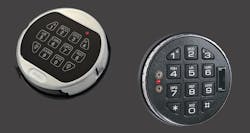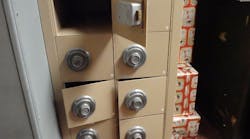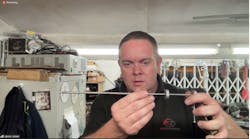Physical security has come a long way over the past few decades. This is particularly true of the electronic combination locks used on safes. Safe locks have moved from mechanical locks to a variety of electronic models that maintain a detailed activity log, also called an audit trail, in addition to a basic level of operation using wireless radio technology (more on this later).
“In the late ’80s or early ’90s, I started my career installing SmartGuard electronic locks that were made by LA GARD,” says Ellis Gibbs, technical instructor with Lockmasters Security Institute. “It was the first electronic safe lock [on the market] where each individual had their own combination code. It was capable of keeping and printing out an audit trail. Now, we have electronic locks that have one or two users and a nine-volt alkaline battery [for power].”
The truth is, safes represent an opportunity for locksmiths to earn additional revenue — and sometimes serious revenue at that. Unfortunately, not every locksmith wants to tackle the installation or ongoing maintenance associated with a safe. Not only do safes require some serious work to install and service, but the level of knowledge required to do so can be complicated and extremely specialized.
Diversification is Crucial
These days, it’s important to wear a number of hats to assure one’s long-term sustainability as a business. In some cases, a locksmith might elect to expand into impulse marketing, investing in odds and ends for use in wall displays and on sales counters. These include keychains, designer key blanks, keychain flashlights and more. (See “The Science of Impulse Buying,” Locksmith Ledger, November 2018, https://bit.ly/2UdWLIB.)
In other cases, a locksmith might decide to diversify into electronic padlocks, such as Master Lock’s 4401LHENT, which provides the advantage of smartphone control through its inclusion of Bluetooth wireless technology. Other possibilities include electronic residential locksets and deadbolts, as well as electronic safe locks.
There are many reasons why end users would want to replace an older mechanical combination lock with an electronic one. When asked why electronic locks are the way to go with regard to combination safe locks, Shaun Stewart, customer service/technical support supervisor with Sargent and Greenleaf (S&G) says, ”Convenience (quicker and easier to access a safe), audio feedback, compatibility with modern technology, as some locks provide the ability to access via a mobile device while others can be centrally controlled. Electronic locks also provide audit-trail capability, multiple modes of operation, a variety of user codes, penalty lockout and time-delay options.”
Not every locksmith takes the plunge, however. According to Gibbs, “In my experience, you have two sets of individuals in this business: You have safe guys, and then you have locksmiths. And then you have those rare individuals who started out doing [general] locksmithing, and then they moved into the safe part of it."
It’s these individuals, who are capable of doing multiple tasks, from unlocking your house, rekeying a home or business and creating a masterkey system for an industrial complex all the way up to installing high-end electronic safe locks, who have long-term market sustainability.
Should You Invest?
Expanding into safes and electronic safe locks requires a huge investment in display goods, tools, stock and technical training.
“As far as investment in [safe] equipment goes, it takes about $10,000 on the low end,” says Alex Bruni, owner of Halt Security Services of Fort Payne, Alabama. “Now, if all you want to do is begin with basic service and combination changes, then $1,000 would get you started. But if you’re interested in opening safes, then $10,000 is a good number to go by. However, moving and installing [safes] could jump that number up to 20 grand, depending on the equipment you decide to use.”
The other aspect of this is education. According to Stewart, “Additional training may be required to install or service certain models. However, locksmiths should consider doing so, especially those who want to diversify into the safe-technician field, as it gives them an expanded skillset [with which] to monetize.”
There’s no denying that safes are a huge step up from general locksmithing, and that’s why it’s important to evaluate whether doing so in the first place makes sense. For example, are there enough commercial businesses in your general operating area to make it a profitable venture for you? Also, how many safe companies are in your local market? Will there be enough business for everyone so your company can realize a net gain? Only you can make that determination.
“There isn’t a one-size-fits-all approach to this,” Bruni says. “Think about automotive mechanics. They can go to a tech school, and they will learn the basic fundamentals of mechanics. They can then go to work for [General Motors] and learn about those particular vehicles. They still wouldn’t know how to work on BMW or Mercedes without taking their specific training. Safe locks work the same way. As for education, Lockmasters has some excellent training classes to get started that cover the basics. The learning process would be ongoing, and it would depend on which particular manufacturers and model safe locks that you intend to work on.”
Upgrading Mechanical Locks
One of the issues that might cause concern among some professional locksmsiths is the issue of standardization among electronic safe locks — or, rather, a lack thereof.
“Bolt work can vary across all safes, which defines the locking mechanism you choose for your safe,” Stewart says.
When asked whether all electronic safe locks are compatible from one safe to another, Bruni says, “Some safes have a standard footprint, which is the layout of the screw pattern that attaches the lock to the safe door. If it is a standard footprint, then it’s easy to convert. For example, replacing an S&G 6730 with an S&G 6120 is as easy as removing a few screws and replacing the lock. No modifications are [probably] necessary. Retrofitting a safe with a standard lock to a Sentry, however, would require extensive modifications and wouldn’t be worth the effort.”
Adapter plates can be purchased to convert one lock-bolt pattern to another. But by and large, when replacing a mechanical combination lock, most safe technicians purchase the lock’s electronic counterpart, simply because the bolt pattern is the same.
Options Available
In terms of the number of users who can access a safe, there’s a wide variation among electronic locks. The LA GARD ComboGard Pro from dormakaba, for example, accommodates up to nine users. The AxisBlu, made by S&G, provides individual passcodes for up to 10 users and up to five mobile devices. In addition, this lock is equipped with Bluetooth connectivity, so users can use their mobile device to gain access.
The ESL10XL and ESL20XL electronic safe locks made by American Security Products also provide mechanical combination-lock replacement, with one- and 10-user passcode capacities, respectively. Both models come with a 15-minute penalty lockout after four failed attempts, in addition to an auto-locking feature that assures that the safe will lock on its own when the bolt-work is thrown.
The ESL20XL, in particular, has a time-delay mode that can range from 1 to 99 minutes, as well as a dual-control feature that requires two different passcode combinations be entered before the safe will open. The time-delay mode can be overridden, such as when an armored car arrives. An optional module is available that provides a silent-duress feature through an onboard relay that can be connected to a separate monitored alarm system installed by a security company.
Allan B. Colombo is a longtime trade journalist and professional in the security and life-safety markets. You can contact him at [email protected], 330-956-9003 or www.tpromocom.com.






